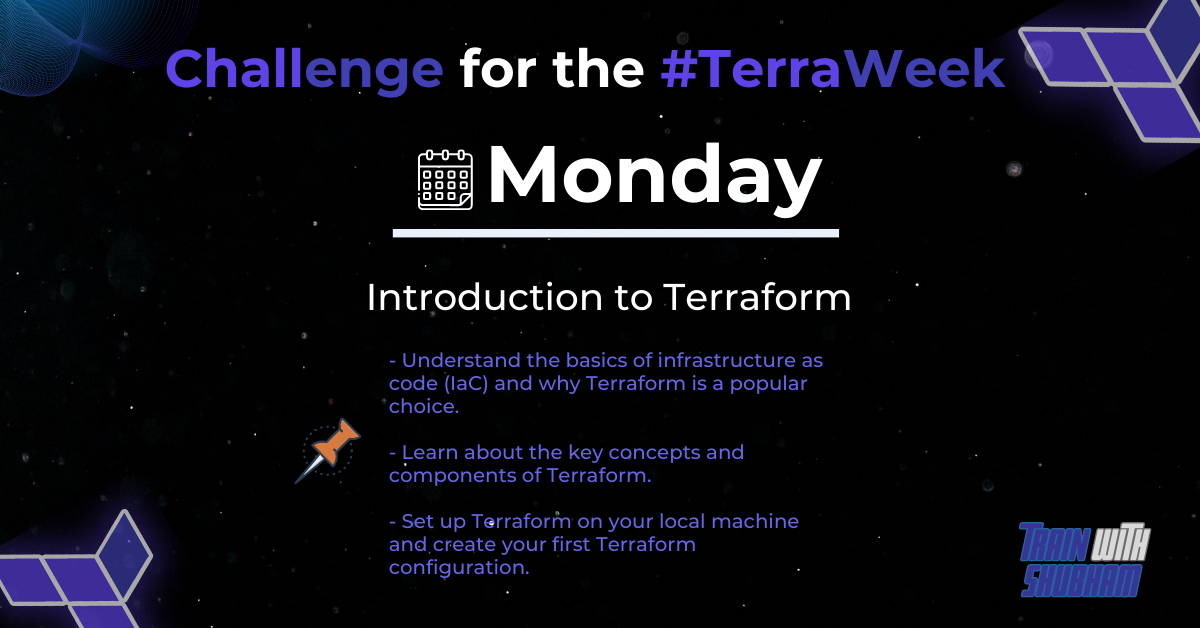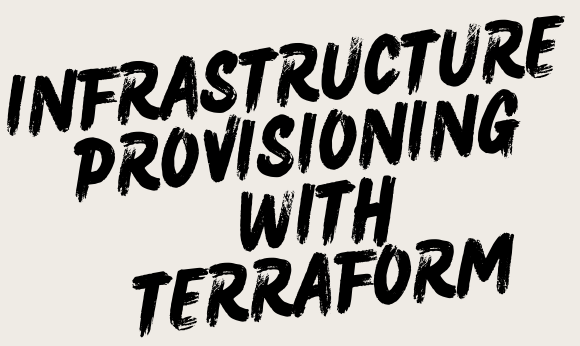TERRAFORM, Day - 1
 Vrishni Shree V B
Vrishni Shree V BTable of contents
- What is TERRAFORM?
- Here are the most important points for beginners to learn and understand about Terraform:
- How can it help you manage infrastructure as code?
- Why do we need Terraform and how does it simplify infrastructure provisioning?
- How can you install Terraform and set up the environment?
- Explain the important terminologies of Terraform with the example of at least (5 crucial terminologies).

What is TERRAFORM?

Terraform is a tool that allows you to define and manage your computer infrastructure simply and efficiently. It uses a language called "Infrastructure as Code," where you write code to describe the desired state of your infrastructure, such as servers, networks, and databases.
With Terraform, you create configuration files that specify the resources you want to create and their desired settings. When you run Terraform, it compares the current state of your infrastructure with the desired state defined in your configuration files. It then automatically makes the necessary changes to bring your infrastructure to the desired state.
By using Terraform, you can easily and reliably create, modify, and destroy infrastructure resources in a consistent and reproducible manner. It helps you avoid manual configuration errors, enables version control for infrastructure changes, and allows for efficient collaboration among team members.
[In summary, Terraform simplifies the process of managing infrastructure by providing a declarative way to define and automate the creation, modification, and deletion of cloud resources. It helps ensure consistency, repeatability, and scalability in managing your infrastructure, all through code.]
Here are the most important points for beginners to learn and understand about Terraform:

Infrastructure as Code: Terraform enables you to define and manage your infrastructure using code, making it easier to version, share, and automate the deployment and management of resources.
Declarative Configuration: With Terraform, you describe the desired state of your infrastructure, rather than writing step-by-step instructions. Terraform takes care of figuring out how to make the actual state match the desired state.
Providers: Terraform supports multiple cloud providers, including AWS, Azure, GCP, and many others. Each provider has its own set of resources and configurations that you can manage with Terraform.
Resources: In Terraform, resources represent the various infrastructure components you want to create and manage, such as virtual machines, networks, databases, and more. You define these resources in your Terraform configuration.
Configuration Files: Terraform configuration files are written in a language called HCL (HashiCorp Configuration Language). They specify the desired infrastructure state and the relationships between resources.
Initialization: Before using Terraform, you need to initialize your project. This downloads the necessary provider plugins and sets up the backend for storing the infrastructure state.
State Management: Terraform maintains a state file that tracks the resources it manages. This state file helps Terraform determine the changes needed to reach the desired state and allows for collaboration among team members.
Execution Plan: Terraform generates an execution plan that shows the actions it will take to bring the infrastructure into the desired state. It helps you preview the changes before applying them.
Apply: The Terraform apply command applies the execution plan, creating, modifying, or destroying resources as needed to reach the desired state. It's important to review the plan and confirm the changes before applying them.
Version Control: Terraform configurations can be stored in version control systems like Git, allowing you to track changes, roll back to previous configurations, and collaborate effectively with other team members.
How can it help you manage infrastructure as code?

Declarative Configuration: Terraform uses a declarative approach, where you define the desired state of your infrastructure in code. This allows you to specify the resources, their properties, and relationships in a human-readable configuration file.
Version Control: Configuration files can be stored in version control systems like Git, enabling tracking, collaboration, and easy rollback. Changes to the infrastructure can be reviewed, merged, and rolled back as needed, providing a reliable audit trail.
Infrastructure Provisioning: Terraform automates the provisioning of infrastructure resources based on the defined configuration. It creates and configures the resources required, such as virtual machines, networks, and storage, according to the desired state.
Resource Lifecycle Management: Terraform manages the entire lifecycle of infrastructure resources. It can create, update, and destroy resources based on changes to the configuration, ensuring consistency and efficient resource utilization.
Dependency Management: Terraform handles dependencies between resources and intelligently determines the correct order of provisioning and modification. It ensures that resources are created or modified in the appropriate sequence to avoid conflicts and errors.
[In summary, Terraform enables infrastructure management as code by using declarative configuration, version control, automated provisioning, resource lifecycle management, and dependency handling. These capabilities provide a powerful and efficient way to manage infrastructure, improve collaboration, and ensure consistency across environments.]
Why do we need Terraform and how does it simplify infrastructure provisioning?

We need Terraform for infrastructure provisioning due to the following reasons:
Infrastructure Consistency: Terraform ensures consistent infrastructure across environments by using declarative configuration files, reducing configuration drift and improving reliability.
Automation: Terraform automates infrastructure provisioning, saving time and reducing errors by automatically creating and managing resources based on the defined configuration.
Scalability: Terraform simplifies scaling infrastructure by allowing you to define the desired capacity, automatically provisioning additional resources to handle the increased load.
Infrastructure as Code: Terraform treats infrastructure as code, enabling version control, collaboration, and applying software engineering practices to infrastructure management.
Multi-Cloud and Hybrid Cloud Support: Terraform supports multiple cloud platforms, allowing you to provision and manage resources across different providers, reducing vendor lock-in and simplifying resource management.
[In summary, Terraform simplifies infrastructure provisioning by promoting consistency, automating resource management, enabling scalability, facilitating infrastructure as code practices, and providing multi-cloud support. These benefits make infrastructure provisioning more efficient, reliable, and adaptable to the evolving needs of your applications.]
How can you install Terraform and set up the environment?
CLICK THIS IMAGE AND INSTALL ON YOUR OS 😁
Explain the important terminologies of Terraform with the example of at least (5 crucial terminologies).
Provider:
Example: Provisioning resources on Google Cloud Platform (GCP) using the Google provider.provider "google" { credentials = file("path/to/credentials.json") project = "your-project-id" region = "us-central1" }Resource:
Example: Creating a Google Compute Engine instance with a specific name, machine type, and zone.resource "google_compute_instance" "example" { name = "my-instance" machine_type = "n1-standard-1" zone = "us-central1-a" }Module:
Example: Using a Terraform module to provision an Amazon Elastic Container Service (ECS) cluster on AWS.module "app" { source = "terraform-aws-modules/ecs/aws" version = "2.0.0" # Configuration options specific to the ECS module }Variable:
Example: Defining a variable for the AWS region where resources will be deployed.variable "aws_region" { description = "The AWS region to deploy resources in." default = "us-east-1" }Output:
Example: Exposing the public IP address of an AWS EC2 instance as output after provisioning.output "public_ip" { value = aws_instance.example.public_ip }

Terraform, the visionary infrastructure as a code tool, empowers organizations to orchestrate their digital landscapes with grace. It simplifies provisioning, unlocking consistency and effortless scalability. By treating infrastructure as elegant code, Terraform ignites collaboration, enabling teams to dance harmoniously. Its multi-cloud magic adds a touch of enchantment, freeing organizations from the shackles of vendor lock-in. With Terraform, your infrastructure symphony reaches new heights, conducting efficient, reliable, and mesmerizing deployments across the celestial realm of the cloud.
Thank you so much for reading.
Follow me on LinkedIn to see interesting posts like this : )
Subscribe to my newsletter
Read articles from Vrishni Shree V B directly inside your inbox. Subscribe to the newsletter, and don't miss out.
Written by

Vrishni Shree V B
Vrishni Shree V B
💻 Python | Docker | Jenkins | Networking | Git | Linux 💻 Passionate about leveraging technology to drive efficiency and deliver innovative solutions. Proficient in Python development, Docker containerization, Jenkins automation, computer networking, Git version control, and Linux administration. Skilled in collaborating with diverse teams to deliver high-quality software products. Proficient in AWS EC2 instance management and deployment. Seeking new opportunities to apply my expertise and contribute to impactful projects. Let's connect and explore how we can work together! Inter-personal Skills: Communication, Adaptability, Emotional intelligence, Active listening, Collaboration. Happy To Connect🔗😊 Feel free to reach me out😃@ --> vrishnishreevb531@gmail.com 📬
